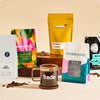With 2019 in the books, it’s a great time to start making travel plans for 2020. And since you’ll almost certainly be drinking coffee throughout your travels, why not pick a destination rich in coffee history? Here are five destinations with a link to specialty coffee’s past and your coffee future.
Holland
While it's true that the café that exists in many of our imaginations of Amsterdam isn’t the kind you might go to for a cappuccino, the Dutch have played an extremely important role in coffee's past. In fact, the first coffee of any historical significance to arrive in Europe did so through Dutch trading routes with Indonesia. Only then did coffee spread to France and then throughout the world.
Currently, Holland’s big cities have no shortage of awesome specialty shops, and the Dutch routinely rank in the top five in studies of most coffee consumed per capita, usually next to their neighbors to the north in Scandinavia.
Italy
Have you heard that Italy takes coffee seriously? The birthplace of espresso received its first coffee through the port of Venice some time around the 16th century. But its biggest contribution to the world of coffee was the invention of the espresso machine around the turn of the 19th century.
Italian espresso is defined very carefully by the National Espresso Institute, and is made with way less coffee (around seven grams) per beverage than most specialty shots. It’s also usually dark roasted, blended, and contains some of Coffea Arabica’s heartier cousin Robusta.
As with many countries, there is a developing scene of specialty roasters offering single origins and lighter roasts. But the typical Italian espresso experience, bellying up to a bar, ordering an espresso, and quickly drinking it right there, is still not to be missed.
Japan
Though more famous for its tea, Japan has an incredibly rich an active coffee culture. As detailed in Merry White’s fascinating ethnography Coffee Life in Japan, coffee arrived in Japan in the early 19th century and the first coffee shop was open by 1888. Its early 20th century coffee boom helped push the Brazilian coffee industry towards the titan it is today.
Japan’s must-visit coffee shops range from traditional small _ kissaten_, where dark-roasted beans are made to order while jazz records play on the stereo, to specialty shops (like Verve's Tokyo shop pictured above) as high end as you can find anywhere. The Nel Drip, a pour over dripper with a sock filter, is a popular brew method, especially at more traditional spots. The Hario V60 pour over and Kyoto iced coffee dripper are Japanese in origin, so if you’re a fan of those brew methods this is the place to be.
Australia
As you may have gathered if you’ve spent time in a large English-speaking city like New York, where their cafés have proliferated wildly over the past few years, Australians are pretty intense about specialty coffee.
Coffee first made its way to Australia on the first European fleet of settlers in 1788, but didn’t make much of a cultural dent until the late 19th century. Some 150 years later, the Australian specialty coffee scene is massively influential. The flat white has been its (or New Zealand’s? Nobody really knows!) chief export, though the piccolo (like a cortado) and the long black (like a tiny Americano) are drinks you might encounter. As in Italy, the scene is much more espresso than drip-focused.
Hawaii
Thanks to its location in the tropics, Hawaii is the only one of the 50 states with a significant coffee growing industry (though we see you, California). According to the Hawaii Coffee Association, coffee first arrived in Hawaii in the early 19th century, with the '80s seeing a spread of major coffee farms throughout Hawaii’s islands.
Partially because of the relatively low altitude of Hawaii’s coffee growing regions (most specialty coffee ranges from 1000 to 2500 meters above sea level, most Hawaiian coffee is in triple digits), Hawaiian coffee is milder and less fruit and flower-forward than many of the specialty coffees you might be used to. That doesn’t mean it’s not super-special, and drinking it close to where it grows is an opportunity you shouldn’t miss (not least of all because it’ll be way less expensive than Hawaiian coffee is once it’s transported to the mainland).






